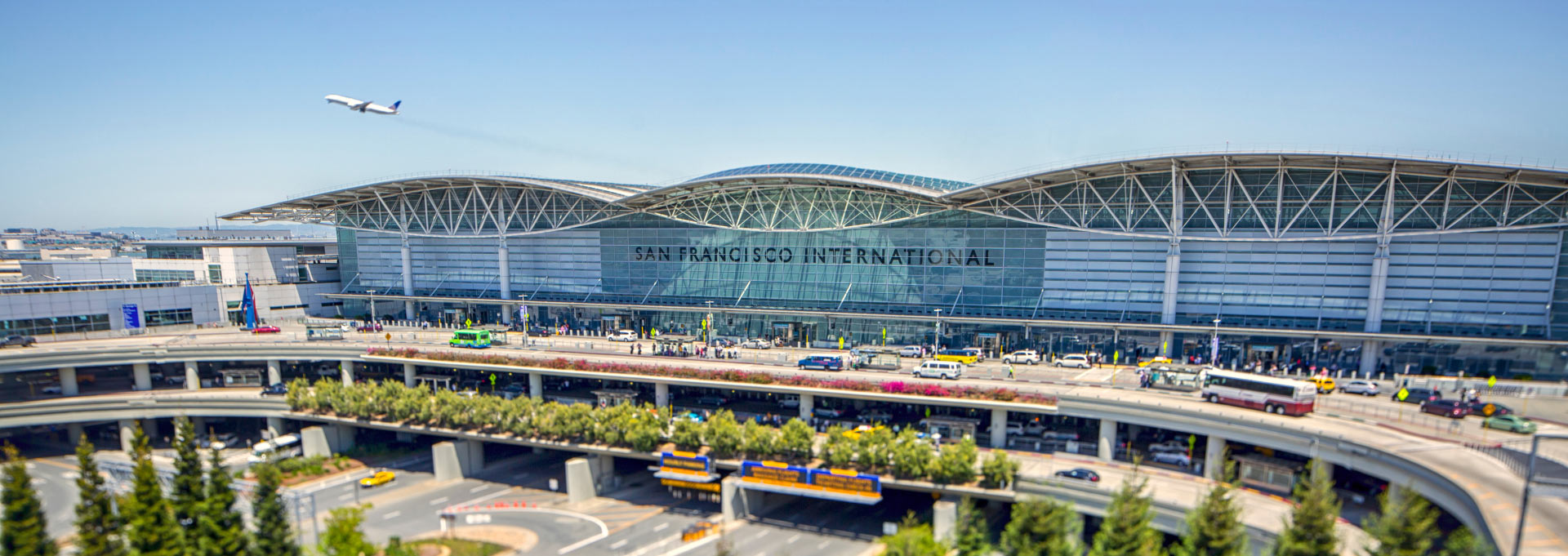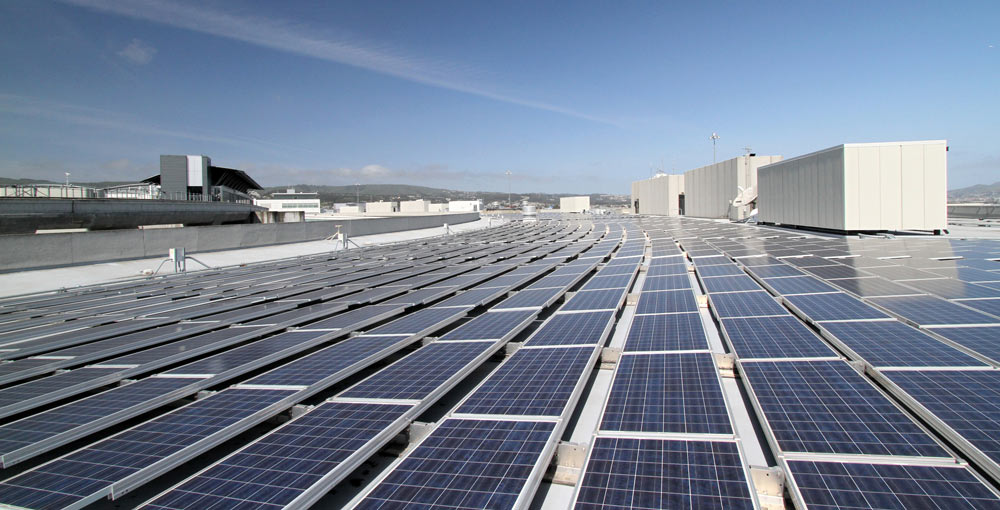
A mission centered on bold climate action
San Francisco International Airport, where safety AND sustainability come first
By Erin Cooke, Sustainability and Environmental Policy Director | San Francisco International Airport
San Francisco International Airport (SFO) has a long history of environmental stewardship, much like the region we serve. Decades ago, we launched programs centered on water conservation and energy reduction. In 2011, we released our first climate action plan and became the first airport in the U.S. with a LEED Gold certified terminal. In 2022, we earned airport-wide certification at the Platinum level through the LEED for Communities program—another global first.
We are proud of our accomplishments. But there is always more to do – our changing climate demands it.
Our new mission statement—“Delivering an airport experience where people and our planet come first”—is at the core of our five-year Strategic Plan released in 2023, making sustainability a guiding principle across our airport and for all who travel and work here. Within this Plan, the Airport elevates its ambition to “take bold climate action” as a means of not only reducing SFO’s climate impact but also driving and inspiring others across the industry to do the same. Our pathway to do so is below.
Triple Zero Commitment & Action
To support our mission and put the planet first, we’ve set a goal of reaching zero net energy, zero net carbon and zero waste by 2030. This industry-leading commitment shapes our decision making—from design and construction through operations.
Zero Net Energy: To always reduce our demands first, then source all our remaining energy from renewables
At SFO, we view zero net energy as both an opportunity and an imperative, particularly in a state with increasing energy shortages and shutoffs. As such, we’ve made significant strides toward hitting our zero net energy goal. In 2015, we opened the world’s first zero net energy airport building to house our critical airfield operations team, and in 2021, we opened Harvey Milk Terminal 1, North America’s most energy-efficient new terminal building and the world’s first airport building to achieve Platinum certification under LEED v4, the newest and most stringent LEED standards. But it’s not just our new terminals, we have to prioritize the 17-million-square-feet of existing, and aging, facilities that have a 50-year useful life. So, we’re monitoring, and retro-commissioning these spaces to ensure all buildings can achieve their peak performance and reduce unnecessary energy demands on campus. In our 2020 Zero Net Energy Plan, we benchmarked the performance of all 100+ buildings onsite, set targets for optimal energy use intensity (EUI) per space, and then developed strategies and capital investments for meeting these EUI goals. We are now implementing those plans through a dedicated team.
Looking ahead, the installation, optimization and continued maintenance of 55 megawatts of solar power across our campus will reduce our onsite energy use and build our resilience during grid emergencies. To address peak-load energy consumption, we’ll continue to load manage our assets (including our growing fleet of EV chargers), while testing smart grid technology and battery energy storage as part of a new redevelopment program that includes warehouses, cargo handling facilities and office buildings, with a goal of broadening the technology to the more energy intensive terminals in approximately five years.

Zero Net Carbon: To reduce airport-controlled greenhouse gas (GHG) emissions to be less than or equal to emissions sequestered on-site, while fostering reductions across our airline and concession partners
As a gateway to one of the world’s most environmentally progressive regions, we know that SFO must lead on climate and, so, have both set GHG targets that outpace those set for our industry by 20 years, while ensuring we also align goals with the United Nations Paris Agreement. While we await the environmental approval, and subsequent design and construction of our all-electric central plant – representing a nearly 90 percent reduction in our onsite emissions – we are electrifying our buildings and ground transportation modes as envisioned in our 2021 Electrification Action Plan and 2020 Zero Emissions Vehicle Readiness Plan. We also continue to drive forward our Lower Emissions via Sustainable Solutions Transportation Policy (SFO LESS), which supports and promotes mobility solutions to, from, and within the Airport. This policy has led to the creation of the SFO Go Shuttle, which offers a faster transit alternative for workers who live in underserved parts of the Bay.
To maximize emissions reductions that arise onsite and truly be bold, we have to go beyond our own facilities and fleet and be intentional about the ways we enable our partners to accomplish their own climate goals. This includes all our tenants who occupy our base buildings and our airlines, who alone emit over 400 times that of the airport itself. For example, we set stringent requirements for all new tenant spaces to operate all-electric and achieve a set EUI. We also run a Sustainable Aviation Fuel (SAF) Working Group alongside our airlines and alternative fuel producers to define SAF infrastructure, logistics, financing and policy needs to prioritize this drop-in fuel for SFO. Through this partnership, SAF volumes continue to climb on campus. In 2022, aircraft at SFO used 11 million gallons of sustainable aviation fuel, and we expect to hit 25 million gallons this year. That represents about 3% of our total gallonage. Our target for 2025 is to get to 5% sustainable fuel.
Zero Waste: To divert at least 90% of waste from landfills and incinerators using methods like source reduction, recycling and composting.
Waste represents an inefficient and recoverable resource that we want to reduce, reuse or reclaim as an asset for our campus and tenants, particularly given the lifecycle and embodied carbon in these materials. Zero waste goals are being realized through policies that promote material reduction first, and reuse next, including designing demolition in a way that allows us to maximize the reclamation of building materials.
In 2019, we were the first airport to ban single-use plastic water bottles, food containers and utensils, and, in 2021 banned all other plastic bottles. This change has allowed us to eliminate 12 million plastic bottles from our waste stream annually, and other corporate campuses even more who have followed in our footsteps. Now, we’re transitioning to both fiber-based food ware that can be easily identified and truly composted, while taking steps towards piloting reusables to fully eliminate this unnecessary material stream.
Health and Well-being
In addition to our triple zero commitments, we place a strong emphasis on designing and maintaining buildings that support the health and well-being of travelers and visitors. As the airport that offered the first yoga room to our passengers, we take this seriously! In 2022, Harvey Milk Terminal 1 became the world’s first airport to receive WELL Certification, a system for measuring the features of a built environment that impacts human health and well-being. Features include:
- Air filtration systems to remove pollutants and odor to meet the indoor air quality requirements of WELL as verified through third-party testing
- Annual water quality testing (with publicly shared results)
- Dynamic glazed windows that change with the sun’s location to reduce glare and improve comfort
- Large windows harnessing daylight to reduce the need for electric lighting
- Purchasing products, systems and materials with the least environmental impact based upon Health Product Declarations (HPDs)
- Green cleaning processes
- Sound reducing surfaces and quieter mechanical systems
This focus enabled us to not only rapidly respond to, and recover from, the pandemic, but creates brighter, cleaner, healthier spaces that improve worker conditions day in and day out.
Accountability and Teamwork
We know that simply putting in new lighting or switching to recycled water isn’t enough. We must also show the impact of our initiatives. So, we’ve developed performance targets for all our initiatives and using data analytics to highlight where we’re winning and where we have more work to do.
We set our bar very high, recognizing that meeting our goals requires partners airport-wide, as well as anyone who interacts with the airport—designers, builders, trades, airlines and travelers – but can also help these climate allies in achieving their own aims.
Bold climate action takes everyone—from our custodians who sort through our materials recovery areas (which is what we call our trash enclosures) to source separate all we can before it heads offsite, to engineers who build the next generation of efficient energy systems, and top leadership— is driven by our mission of “delivering an airport experience where people and planet come first.”
Cross-disciplinary teams have been bringing together SFO staff, business partners and community leaders for over a decade to promote crowd-sourcing of sustainable solutions. Sometimes, big climate wins come in surprising places. Human Resources, Finance and Guest Services launched a waste reduction program that donates leftover food to nonprofits–14,000 meals last year alone.
Ensuring a better, bolder tomorrow
As the largest employer and economic driver in our region, our 2,000+ climate committed employees feel a duty to ensure that SFO is built to last for the betterment of the entire area. SFO is doing this and more, as we aim to be the first airport in the world to achieve “triple zero.” With each decision that we make, we hope to demonstrate to the industry that it’s possible to take impactful action today to ensure a better tomorrow.
ABOUT THE AUTHOR
 Erin Cooke
Erin Cooke
Sustainability and Environmental Policy Director
San Francisco International Airport
Erin is San Francisco International Airport’s first Sustainability Director. She is responsible for partnering with the Airport community to co-design, manage, and administer sustainability policies, projects, and programs that mitigate greenhouse gas emissions, maximize net positive outcomes, and magnify SFO’s environmental leadership. She oversees sustainability investments in capital improvement projects and leads the Airport’s Sustainability and Environmental Management, Resilience and Adaptation, Climate Action, Zero Net Energy and Zero Waste Plans.
